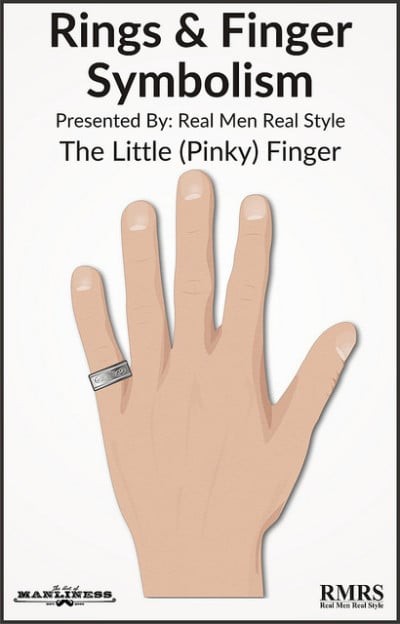Rings, beyond the simple wedding band, make a statement. For millennia, men have used them to denote status, wealth, commitment, and affiliations. From signifying unavailability to marking attendance at a prestigious academy, rings communicate volumes. But how do you wear them with confidence and intention? This guide explores the symbolism behind wearing rings and provides a framework for incorporating them into your personal style.
Understanding Ring and Finger Symbolism
There aren’t strict rules about which hand to wear a ring on, excluding engagement and wedding rings tied to specific cultural norms. While American men often wear wedding bands on the left ring finger, those married in the Eastern Orthodox tradition may opt for the right. Instead, consider the hand’s symbolism in relation to the ring’s meaning. The right hand is often seen as the “physical” hand – active and expressive. The left is the “mental” hand, representing character and beliefs. Ultimately, personal preference reigns supreme.
Let’s explore each finger and the symbolism associated with it:
The Little (Pinky) Finger
The pinky is a popular choice for a statement ring. It avoids the religious and cultural associations linked to the ring finger and doesn’t interfere with the index finger. A pinky ring draws attention and is often where men choose to display bolder designs. If you prefer a more subtle look, opt for a slim ring with a subdued tone. Symbolically, the pinky is linked to Mercury, representing intelligence, discernment, and persuasion. When worn on the active hand, it indicates intellect and articulateness. On the passive hand, it represents intuition and strong listening skills.
The Fourth (Ring) Finger
The ring finger is globally associated with marriage. In North and South America, a band on the right fourth finger signifies engagement, while the left indicates marriage. Most men choose a simple band as their wedding ring, although unique and artistic alternatives are becoming increasingly popular. Symbolically, the ring finger is connected to the sun, representing creativity, beauty, and romantic relationships. Gold is the traditional metal for wedding bands, mirroring the sun’s metal. Historically, it was believed that this finger contained an unbroken artery leading directly to the heart, symbolizing an eternal bond.
The Middle Finger
The middle finger is the most prominent and boldest. Wearing rings on the middle finger is less common due to its proximity to the index finger, which can hinder manual tasks. If you choose this finger, keep the ring simple and small. For first-time ring wearers, the middle finger can feel comfortable and “manly.” It avoids confusion with wedding or engagement symbolism. Symbolically, the middle finger represents structure, balance, conscience, and order, and is associated with Saturn. Steel and other gray metals are often chosen for middle finger rings, reflecting Saturn’s metal, lead.
The Index (Pointer) Finger
The index finger was historically the most common place for men to wear rings, often signets or crests denoting family status. While there’s a natural instinct to keep the pointer finger clear, a ring on this finger doesn’t interfere as much as one on the adjacent finger. The index finger is a great place for class rings, fraternal rings, or family crests. If you want a ring to be used frequently and emphatically in your gestures, the index finger is ideal. Astrologically, it’s associated with Jupiter, symbolizing power, leadership, and authority. Men wearing rings on this finger are often seen as confident and unapologetic. Silver tones are a common choice for the index finger, inspired by tin, the metal associated with Jupiter.
The Thumb
Thumb rings have a slightly unconventional feel but are reasonably common worldwide. They often signify wealth or influence and tend to be broad and bulky. The thumb is a good choice for men who want to wear multiple rings on the same hand, as it provides space between the others. Thumb gestures are associated with interaction and friendship. Choose a ring that people will like – bold and chunky is fine, but avoid anything too gaudy or expensive. The thumb symbolizes strength of character, identity, will, and self-assuredness.
The 5 Rules of Wearing Rings for Men
Wearing rings confidently goes beyond understanding symbolism. Here are five essential rules:
Rule #1: Every Ring Sends a Message
Be aware that rings communicate. Class rings identify your affiliation with institutions. Large gold rings with precious stones signal wealth and power. Marriage and engagement rings quickly indicate relationship status. People notice rings, so be mindful of the messages you’re sending, especially in professional or conservative settings. A ring can be a conversation starter, so be prepared to share its story.
Rule #2: Be Confident
Confidence is key. If you’re not comfortable wearing a ring, start by wearing it at home to get used to the feel. Then, wear it around trusted friends and gauge their reactions. Know the story behind your ring and be prepared to answer questions about it. A unique ring can be an excellent conversation piece.
Rule #3: Maintain Proportion to Your Hands
Proportionality matters. Men with large hands can wear larger rings, while those with smaller hands should opt for smaller, more delicate designs. Similarly, slim fingers suit compact rings, while fuller fingers can carry broader bands. Ensure any gifted ring is appropriately sized for your finger.
Rule #4: Balance the Ring(s) With Other Jewelry
Balance the overall look. Distribute jewelry evenly across both hands. If you’re wearing a wedding band and a watch on one hand, consider adding a bracelet to the other wrist. Avoid crowding rings, a watch, and bracelets on one hand while leaving the other bare. If you want to add another ring, consider the opposite ring finger or index finger.
Rule #5: Match Metals
Matching metals creates a cohesive look. Choose between silver or gold based on your skin tone. If you have cool undertones (visible blue veins), opt for silver. If you have warmer undertones (veins not clearly visible), choose gold. Ideally, the metal on your belt buckle, watch strap, and rings should be similar. Uniformity simplifies jewelry choices.
Finding Your Ring Style
Two or three rings spread across both hands is generally considered a safe maximum. More than that can appear excessive. A single bold statement ring on one hand can be highly effective.
Ultimately, quality is more important than quantity. Whatever your choices, following these five rules will guide you toward a confident and stylish approach to wearing rings.

